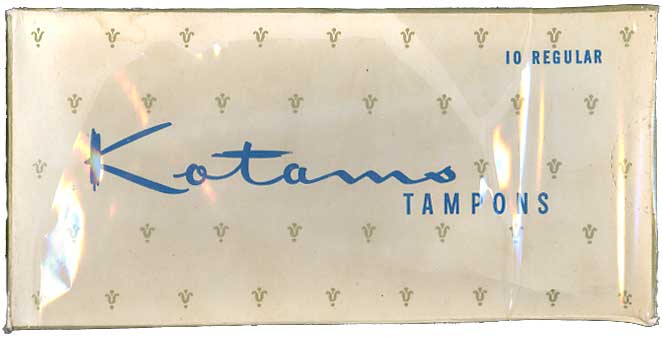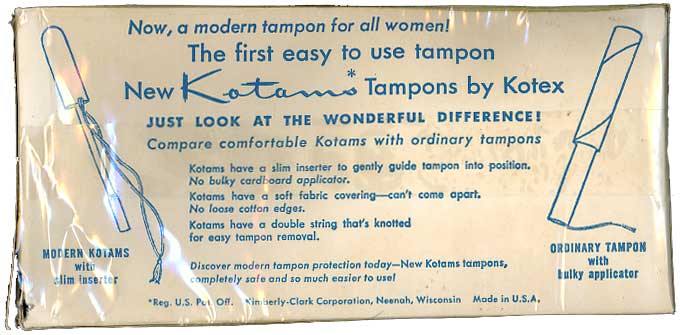|


|

MUSEUM OF MENSTRUATION AND WOMEN'S
HEALTH
Kotams first
Kotex stick menstrual tampons
(Kimberly-Clark Corp., maker of Kotex
menstrual pads, panties, belts, educational booklets),
1960-65,
U.S.A.
The Kimberly-Clark company had
failed with its first successful
tampon, Fibs,
as well as with its shadowy
predecessors Moderne
Woman,
fax,
and Nunap. Now
it wanted to try again to bite a
mouthful out of Tampax,
the leader then and now.
This maker of Kotex, the
menstrual pad leader, thought that
women would find using a stick to
insert a tampon simpler than using
Tampax's ancient, large tubes.
The company introduced Kotams in
1960 but by 1965 found that it had
earned too little money for the
effort. Women had rejected another
Kotex tampon.
But the next year it
reintroduced the stick idea under
another
name, with cheaper
production cost and with a great ad
campaign. This tampon lasted
longer.
(Some of this information comes
from "Kotex, Kleenex, Huggies:
Kimberly-Clark and the Consumer
Revolution in American Business,"
2004, by Thomas Heinrich and Bob
Batchelor. In the Acknowledgments,
the authors kindly
called this museum Web site "a
treasure trove of information.")
Hi Harry.... It's me, the
former teacher and contributor
**** at a new email address....
I read your comments about the
stick tampons with interest and
I can only tell you from my
perspective and experience what
was wrong with them....to be
honest they were easier to
insert and the stick was not
actually attached it was just in
a recessed area of the tampon so
to remove it after insertion was
even easier than the cardboard
tubes that would sometimes be
more difficult if you hadn't
completely gotten the tampon out
of the tube etc......but at the
same time when you opened the
tampon wrapper the stick
sometimes had fallen out and you
would have to replace it in the
spot and worse when it had been
dislodged it often was bent or
broken....the tampon itself
didn't have the protection of
that tube....none of that was a
problem straight from the box at
home nor was it if you used a
hard plastic tampon case to
carry it in your purse but the
reality most of us just threw a
wrapped package in our purse and
went....we weren't staying home
with the tampon box in the
70's.....rolling around in the
bottom of your purse with the
loose change and lipstick the
wrappers would tear a bit
sometimes, the stick would bend
or break and the tampon itself
was not protected the way it is
in the tube until ready to
use.....the
design was great and easier to
use fresh out if the box but
not durable enough in the way
women were actually
transporting them and using
them.
It really would be helpful to
ask a
woman sometimes when
designing products. [Read what
the ad man for early Kotex wrote
about women writing ads for
Kotex.]
I thank
the former Tambrands for
donating the box!
|
Below:
The box measures 6 x 3 x 1" (15.5
x 7.6 x 2.5 cm) and is enveloped
with
cellophane. That fleur-de-lis-like
design - a touch of class with the
gold - looks like
rows of
menstrual cups. Maybe
Kotex had them on their
competitive minds
since cups
were then reappearing among the
U.S. public.
Flowers
have a long, ironic association
with menstruation.
|
 |
Below:
Kotex was trying to lure women
away from Tampax, the leading
tampon by far.
The company pushed the idea that stick tampons
were SIMPLER (see ad for its
second stick tampon)
to use but women didn't buy the
idea and Kotex replaced
THIS stick tampon with another.
Kotex slaps
Tampax by calling it ordinary
- that's a drawing of a Tampax at
right.
I wonder if the stick
subliminally frightened women:
a sharp stick impaling the uterus
or ripping the vagina?
"Modern"
might have been a way to reduce Tampax's
advantage of having been around
since the
beginning of commercial tampons in
the early 1930s; Kotex's first
successful tampon had
failed.
|
 |
Below:
The sides and ends are gold and
darker than the front and back.
The opposite side is identical.
|
 |
Below:
The other end is identical.
|
 |
NEXT | tampon - instructions
© 2009 Harry Finley. It is illegal to
reproduce or distribute any of the work on
this Web site
in any manner or medium without written
permission of the author. Please report
suspected
violations to hfinley@mum.org\
|